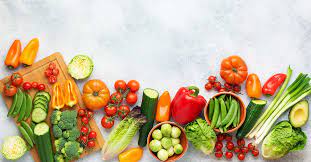this vegetables is good for health

These are vegetables are more benefical for human health;
Carrot is a root vegetable known for its crisp texture, sweet taste, and vibrant orange color. Here's some information about carrots:

-
Nutritional Profile: Carrots are highly nutritious and are a good source of vitamins, minerals, and dietary fiber. They are particularly rich in beta-carotene, which is converted to vitamin A in the body and contributes to eye health, immune function, and healthy skin.
-
Varieties: While the most commonly known carrot is orange, carrots come in various colors including purple, yellow, red, and white. These different varieties may vary slightly in taste and nutritional composition.
-
Health Benefits: Carrots offer several health benefits. They are low in calories and fat, making them a healthy choice for weight management. The dietary fiber in carrots helps support digestion and promote feelings of fullness. The antioxidants in carrots, including beta-carotene and other compounds, contribute to their potential benefits for reducing the risk of chronic diseases such as heart disease and certain types of cancer.
-
Eye Health: Carrots are often associated with supporting eye health due to their high beta-carotene content. Beta-carotene is converted to vitamin A in the body, which is essential for good vision. Adequate vitamin A intake is important for maintaining proper eye function and may help protect against age-related macular degeneration and night blindness.
-
Culinary Uses: Carrots are versatile and can be consumed raw or cooked. They can be enjoyed as a crunchy snack, added to salads, soups, stir-fries, or roasted as a side dish. Carrots can also be used in baking, such as carrot cakes or muffins, adding natural sweetness and moisture to recipes.
-
Storage and Preparation: To keep carrots fresh, remove the green tops (if still attached) and store them in a cool, dry place or in the refrigerator. Properly stored carrots can last for several weeks. Before consuming, rinse the carrots to remove any dirt, and you can peel them if desired, although the skin is edible and contains nutrients.
-
Culinary Pairings: Carrots can be paired with a variety of flavors and ingredients. They work well with spices like ginger, cumin, or coriander, and are often combined with other vegetables in stews or stir-fries. Carrots can also be used in sweet dishes with ingredients like cinnamon or honey.
cabbage;
Cabbage is a leafy vegetable that belongs to the Brassica family, which also includes other cruciferous vegetables like broccoli, cauliflower, and Brussels sprouts. It is known for its round or oval-shaped head with tightly packed leaves. Here's some information about cabbage:

-
Varieties: Cabbage comes in various types, including green cabbage, red cabbage, Savoy cabbage, Napa cabbage, and Bok choy. Each variety has its own unique flavor, texture, and culinary uses.
-
Nutritional Value: Cabbage is low in calories and rich in essential nutrients. It is a good source of vitamins C and K, as well as dietary fiber. Cabbage also contains small amounts of other vitamins and minerals like vitamin B6, folate, calcium, and potassium.
-
Health Benefits: Cabbage is known for its numerous health benefits. It is packed with antioxidants, which help protect against cell damage and reduce the risk of chronic diseases. The fiber content in cabbage aids in digestion and promotes a healthy digestive system. Cabbage is also associated with potential anti-inflammatory and anti-cancer properties.
-
Culinary Uses: Cabbage is a versatile vegetable that can be used in a variety of culinary preparations. It can be eaten raw in salads, coleslaws, or fermented into sauerkraut or kimchi. Cabbage can be cooked by steaming, stir-frying, boiling, or roasting. It is used in a wide range of dishes such as soups, stews, stir-fries, wraps, and side dishes.
-
Storage and Preparation: To store cabbage, it is best to keep it in the refrigerator in a plastic bag or wrapped in a damp cloth to maintain its freshness. Whole heads of cabbage can last for several weeks when stored properly. Before cooking or consuming, remove the outer leaves and wash the cabbage thoroughly.
-
Culinary Tips: When cooking cabbage, be mindful of the cooking time as prolonged cooking can lead to a strong odor and loss of nutrients. To retain its crunch and nutrients, consider lightly steaming or stir-frying cabbage. Cabbage pairs well with various ingredients, including onions, garlic, carrots, apples, bacon, and spices like caraway seeds or dill.
-
Cultural Significance: Cabbage is a staple in many cuisines worldwide. It is commonly used in European, Asian, and American cooking, appearing in traditional dishes such as coleslaw, sauerkraut, cabbage rolls, kimchi, and borscht.
Onions;
Onions are edible bulb vegetables known for their distinctive flavor and widespread culinary use. Here's some information about onions:

-
Varieties: Onions come in various types, each with its own taste and culinary uses. Common varieties include yellow onions, which have a strong flavor and are widely used in cooking; red onions, which have a milder flavor and add color to dishes; and white onions, which have a sharper taste and are often used in Mexican cuisine. Other varieties, such as shallots and green onions (scallions), are also popular.
-
Flavor and Aroma: Onions have a pungent flavor and a characteristic aroma. When chopped or cooked, they release sulfur compounds that give them their distinctive taste and smell. The flavor profile of onions can range from mildly sweet to sharp and tangy, depending on the variety and preparation method.
-
Culinary Uses: Onions are a staple ingredient in many cuisines around the world. They serve as a base ingredient in numerous savory dishes, including soups, stews, sauces, stir-fries, and salads. Onions can be sautéed, caramelized, grilled, roasted, or used raw, depending on the desired flavor and texture.
-
Nutritional Value: Onions are low in calories and a good source of essential nutrients. They contain vitamins C and B6, folate, potassium, and dietary fiber. Onions also contain antioxidants, particularly flavonoids, which are believed to have various health benefits.
-
Health Benefits: Onions have been associated with several potential health benefits. The antioxidants in onions may help reduce inflammation, support heart health, and boost the immune system. Some studies suggest that onions may have antibacterial and antiviral properties. Additionally, onions contain prebiotics, which can promote a healthy gut microbiome.
-
Storage and Shelf Life: To store onions, it's best to keep them in a cool, dry, and well-ventilated area. Whole onions can last for several weeks to a few months, depending on the variety. Once an onion is cut, it should be stored in a sealed container in the refrigerator and used within a few days.
-
Tips and Precautions: Onions can cause tears when cut due to the release of volatile compounds. To minimize tearing, chilling the onion in the refrigerator or cutting it under running water may help. Some individuals may also be sensitive or allergic to onions and may experience digestive discomfort or allergic reactions
tomato;
Tomato is a popular fruit that is often used as a vegetable in culinary preparations. Here's some information about tomatoes:

-
Botanical Classification: Tomatoes belong to the Solanaceae family, which includes other plants like potatoes, peppers, and eggplants. Scientifically, tomatoes are classified as Solanum lycopersicum.
-
Varieties: There are numerous varieties of tomatoes, varying in size, shape, color, and taste. Common varieties include cherry tomatoes (small and round), beefsteak tomatoes (large and meaty), Roma tomatoes (plum-shaped), and heirloom tomatoes (heritage varieties with unique characteristics).
-
Nutritional Profile: Tomatoes are packed with nutrients. They are a good source of vitamins A, C, and K, as well as potassium and folate. They are also low in calories and fat while containing beneficial antioxidants, including lycopene, which gives tomatoes their red color.
-
Culinary Uses: Tomatoes are a versatile ingredient used in various cuisines worldwide. They can be eaten raw, sliced in salads, or used as a base for sauces, soups, stews, and salsas. Tomato paste, tomato sauce, and ketchup are common tomato-based condiments. Sun-dried tomatoes and tomato juice are also popular preparations.
-
Health Benefits: Tomatoes offer several health benefits. They are rich in antioxidants, which help protect the body against cell damage and certain diseases. The lycopene found in tomatoes has been associated with a reduced risk of heart disease and certain types of cancer. Tomatoes also contain dietary fiber, which aids in digestion.
-
Growing Tomatoes: Tomatoes can be grown in home gardens or on a larger scale in agricultural settings. They thrive in warm climates and require well-drained soil, adequate sunlight, and regular watering. Tomato plants can be grown from seeds or purchased as seedlings for transplanting.
-
Tomato Varieties: Besides the traditional red tomatoes, there are also yellow, orange, green, and even purple varieties available. Each variety may have its unique flavor profile and culinary applications.
potato;
Potato is a starchy root vegetable that belongs to the nightshade family. It is one of the most widely consumed and versatile food crops globally. Here's some information about potatoes:

-
Varieties: There are numerous potato varieties, each with its own characteristics in terms of taste, texture, and color. Some popular varieties include Russet, Yukon Gold, Red Bliss, Fingerling, and Purple Potatoes.
-
Nutritional Value: Potatoes are a good source of carbohydrates, dietary fiber, and several essential nutrients. They contain vitamin C, potassium, vitamin B6, and trace amounts of other vitamins and minerals. The nutritional content varies depending on the variety and cooking method.
-
Culinary Uses: Potatoes are incredibly versatile in cooking and can be prepared in various ways. They can be boiled, steamed, mashed, roasted, fried, or used in soups, stews, and salads. Potatoes are also used to make popular dishes like French fries, mashed potatoes, potato chips, and gratins.
-
Storage and Preparation: Potatoes are typically stored in a cool, dark, and well-ventilated place to prevent sprouting or spoilage. Before cooking, they are usually washed, peeled (if desired), and cut into the desired size or shape.
-
Health Benefits: Potatoes provide several health benefits. They are a good source of dietary fiber, which aids in digestion and promotes satiety. Potatoes also contain antioxidants that help protect against cellular damage. However, the overall nutritional value of potatoes can be influenced by cooking methods and added ingredients like oils and sauces.
-
Culinary Considerations: While potatoes can be a nutritious part of a balanced diet, it's important to be mindful of portion sizes and cooking methods. Boiling or steaming potatoes without added fats can be a healthier option compared to deep-frying or consuming them in large quantities as high-calorie dishes.
-
Cultural Significance: Potatoes are a staple food in many cuisines around the world. They have played a significant role in the history and cultural traditions of various regions, such as Ireland (where potatoes were a dietary staple), Germany (known for potato dishes like kartoffelpuffer), and Peru (the ancestral home of potatoes with numerous native varieties).
leamon;
I assume you meant "lemon," which refers to a citrus fruit known for its sour taste and acidic juice. Here's some information about lemons:

-
Appearance and Flavor: Lemons are small, yellow citrus fruits with a bright, tangy flavor. They have a smooth, thin, and textured peel that is rich in essential oils, giving them their distinctive aroma.
-
Nutritional Profile: Lemons are low in calories and a good source of vitamin C, providing about 64% of the recommended daily intake per 100 grams. They also contain smaller amounts of other vitamins and minerals like vitamin B6, potassium, and folate.
-
Culinary Uses: Lemons are widely used in cooking and baking, as well as for their juice and zest. The acidic juice of lemons is often used as a flavoring agent in various dishes, beverages, dressings, and desserts. Lemon zest, which is the grated outer peel, adds a bright, citrusy flavor to recipes.
-
Health Benefits: Lemons offer several potential health benefits. Vitamin C is an antioxidant that helps boost the immune system and may protect against certain chronic diseases. The citric acid in lemons may aid digestion, and some studies suggest that it may have antimicrobial properties. Additionally, lemon water is a popular choice for hydration and can help promote a healthy pH balance in the body.
-
Household and Cleaning Uses: Lemons have various non-culinary applications as well. The acidity of lemon juice makes it effective for removing stains, cleaning surfaces, and acting as a natural deodorizer. Lemon juice can be used as a natural bleach alternative, polish copper and brass, or freshen the scent of the air.
-
Other Varieties: While the common lemon is the most widely recognized, there are also other lemon varieties available, such as Meyer lemons. Meyer lemons are smaller, rounder, and have a sweeter flavor with a hint of mandarin orange. They are often used in desserts and cocktails.
-
Lemon Symbolism: Lemon symbolism varies across cultures. In some traditions, lemons are associated with freshness, purity, and cleansing. They are also a common symbol of good luck and prosperity in some cultures.
mint;
Mint is a popular personal finance management tool that helps individuals and households track their financial transactions, set budgets, and gain insights into their spending habits. Here's an overview of Mint and its features:

-
Account Aggregation: Mint allows users to link their bank accounts, credit cards, loans, investments, and other financial accounts in one place. It automatically pulls in transaction data from these accounts, providing a comprehensive view of their financial situation.
-
Budgeting and Goal Setting: Mint helps users create budgets based on their income and expenses. It categorizes transactions and provides visualizations and reports to track spending in various categories. Users can set financial goals, such as saving for a vacation or paying off debt, and monitor their progress toward those goals.
-
Expense Tracking and Categorization: Mint automatically categorizes transactions based on merchant information, making it easier to see where money is being spent. Users can also manually categorize transactions for greater accuracy. This feature allows individuals to identify areas where they may need to adjust their spending habits.
-
Bill Reminders and Alerts: Mint provides bill reminders and alerts to help users stay on top of their financial obligations. It sends notifications for upcoming bills, payment due dates, and unusual spending patterns, helping users avoid late fees and overspending.
-
Credit Score Monitoring: Mint offers a credit score monitoring feature that allows users to track changes in their credit score over time. It provides insights into factors that impact credit scores and offers personalized tips to improve creditworthiness.
-
Financial Insights and Recommendations: Mint provides personalized insights and recommendations based on users' financial data. It offers suggestions for potential savings, identifies subscription services that can be canceled, and provides advice on how to reduce fees and optimize financial decisions.
-
Mobile Apps and Integration: Mint is available as a mobile app for iOS and Android devices, allowing users to manage their finances on the go. It also integrates with various financial institutions, making it easy to sync account data and access real-time financial information.
Ginger;
Ginger is a flowering plant that belongs to the Zingiberaceae family. It is widely known for its aromatic, spicy, and slightly sweet flavor. Ginger is native to Southeast Asia but is now cultivated in various regions worldwide for both culinary and medicinal purposes. Here's some information about ginger:

-
Culinary Uses: Ginger is a versatile ingredient used in many cuisines around the world. It can be used fresh, dried, powdered, or as a paste. Ginger adds a distinct flavor and aroma to dishes, ranging from spicy and pungent to mildly sweet. It is commonly used in soups, stir-fries, curries, marinades, baked goods, teas, and beverages like ginger ale.
-
Medicinal Properties: Ginger has been used for centuries in traditional medicine due to its potential health benefits. It contains bioactive compounds such as gingerol, shogaol, and zingerone, which have anti-inflammatory, antioxidant, and antimicrobial properties. Ginger is believed to aid digestion, relieve nausea, reduce inflammation, alleviate muscle pain, and support immune health. It is often used as a natural remedy for various ailments, including nausea and morning sickness.
-
Digestive Aid: Ginger is known to have carminative properties, which means it can help reduce gas and alleviate bloating and discomfort in the digestive system. It is commonly used to relieve indigestion, improve appetite, and support overall digestive health.
-
Anti-Nausea Effect: Ginger is well-regarded for its ability to ease nausea and vomiting. It is commonly used as a natural remedy for motion sickness, morning sickness during pregnancy, and post-operative nausea. Many people find ginger effective in reducing queasiness and promoting a settled stomach.
-
Culinary and Beverage Uses: Ginger is widely used in various culinary creations. It can be grated, sliced, minced, or juiced to infuse its flavor into dishes. Ginger is a key ingredient in Asian cuisines, particularly in dishes like ginger chicken, ginger beef, and ginger-infused soups. It is also a common component in baking, adding a warm and aromatic touch to cookies, cakes, and bread.
-
Forms and Storage: Ginger is available in different forms, including fresh ginger root, dried ginger, ginger powder, and ginger paste. Fresh ginger root should be stored in a cool and dry place, while powdered or dried ginger can be kept in airtight containers in a cool and dark location to maintain its flavor and potency.
-
Precautions: While ginger is generally safe for most people when consumed in moderate amounts, it's always a good idea to consult with a healthcare professional, especially if you have any underlying medical conditions or are taking medications. High doses of ginger or prolonged use may cause digestive discomfort or interact with certain medications.
Ginger's distinctive flavor and potential health benefits have made it a popular ingredient in various culinary dishes and natural remedies worldwide. Whether used in cooking or consumed for its medicinal properties, ginger adds a unique and flavorful element to many dishes and beverages.








